Some information may be outdated.
When Todd Anderson, a printmaker, came across an article about glacial retreat in Glacier National Park in 2010, he was hooked. Glaciers in the park were then, and are now, rapidly retreating; Anderson, an artist, thought he could help people understand the phenomenon through artwork.
“I looked around to see if any artists were documenting what was happening up there,” he said. “But no one was—so I decided to start doing it myself.”
Anderson and Bruce Crownover, who met when Crownover was Anderson’s professor at the University of Wisconsin-Madison, spent four years in Glacier National Park documenting the glaciers. Their work turned into “The Last Glacier,” a book that “shares the wonder of the park’s glaciers while simultaneously serving as a historical document of climate change in Glacier National Park,” according to the book’s description.
Now, Anderson and Crownover are pursuing another, similar project in documenting the effects of global heating on the environment: they recently published “Sentinels,” a book and art exhibit exploring the piñon pine and juniper trees of the Bears Ears and Grand Staircase-Escalante national monuments. The exhibit will be on display at the Moab campus of Utah State University through May; there will also be an opening reception on Friday, March 3 from 6 to 8 p.m.
“I think art is a really great tool—it tends to engender an openness to larger discussions,” Anderson said. “The artwork we make isn’t necessarily political, it’s not ideological, it’s more about, first and foremost, celebrating the wonder of these places or these things, like trees or glaciers … We’re trying to use art as a hook, and creating a bridge between science and art.”

Anderson said he came across a paper about aridification—how the desert is becoming drier and hotter—and how that changing weather is impacting trees. He wanted to document the phenomenon for himself, and so he again invited Crownover to join him in creating a project. The two reached out to Gary Machlis, a professor of environmental sustainability at Clemson whose research focuses on conservation science, and spent two years taking trips to Bears Ears and Grand Staircase.
“Knowledge alters the way we perceive the world,” Anderson said.
Anderson and Crownover are woodcut printers: they both gather sketches and photos in the field to then turn into prints at their studios. Anderson said the process of making a print can take a few months from start to finish—the wood blocks are 23 by 30 inches, and each separate color requires a new, hand-carved layer. Each artist has six prints in the project.
Capturing the beauty of trees was more difficult than mountains or glaciers, Crownover said, despite their familiarity (his family visited Southeast Utah many times when he was growing up). His printmaking process is very slow, he said, as he goes layer by layer. He said he hopes his prints can draw people in.
“I want people to be like, ‘oh, look at this colorful thing, what is this?’ And then realize they’re looking at something that is disappearing,” Crownover said.
Machlis created what he calls “word paintings” for the project: texts that are both visual art and information. Machlis made three works, which explore the role of the pine trees in fictional and decade-spanning stories. One is written and designed in the style of an 1880s travel journal, one in the style of an imagined newspaper editorial written in the 1950s, and the last is a science article worded as though it was written in the 1970s.
“My involvement was as a scientist doing art with artists,” he said—his works give context to the artwork while continuing the project’s creativity.
“I’m super honored to come back to Utah to share our research and all this visual information,” Anderson said. “It feels really good to come back and share it with the communities there—it’s just another perspective on where they live, because it’s such a beautiful part of the world.”
The exhibit will be on display at the Moab campus of Utah State University through May. The opening reception will be held on Friday, March 3 from 6 to 8 p.m.
Appreciate the coverage? Help keep local news alive.
Chip in to support the Moab Sun News.





